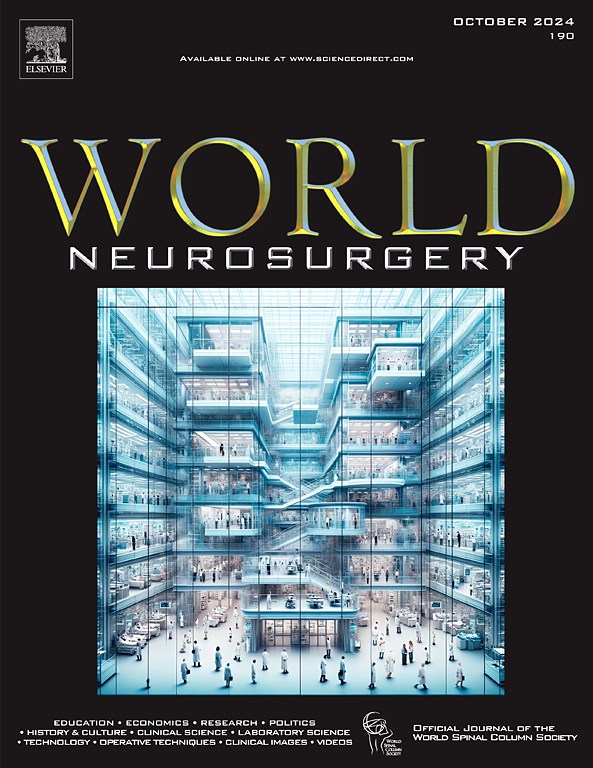锁孔椎板内背根切断术:单中心评估该技术的可行性、有效性和无公害。
IF 2.1
4区 医学
Q3 CLINICAL NEUROLOGY
引用次数: 0
摘要
目的:研究2018 - 2023年在Nancy儿科神经外科应用Keyhole椎板间背根切断术(Keyhole intralalar Dorsal Rhizotomy, KIDr)的可行性、疗效、无公害,并探讨并发症的性质。材料和方法:我们对2018年1月至2023年12月在我院接受手术的62名儿童进行了回顾性分析,采用了Keyhole椎板内背侧根切开术(KIDr)技术。我们注意到手术的持续时间,以及术中面临的困难,这将有助于评估所使用的手术方式的可行性。我们还使用改良Ashworth量表(MAS)在手术前和手术后一年以及大运动功能分类系统(GMFCS)控制痉挛的演变。我们最后评估了手术后一年内发生的并发症。结果:在我们分析的5年以上的62例患者中,平均手术时间为250.3分钟,具有真正的学习曲线。我们在手术过程中没有并发症,除了一个病人有一个特殊的形态。8例患者需要长时间的电生理监测,但没有手术后果。在手术后的第一年,我们的并发症发生率与文献中描述的其他选择性背根切断术(SDR)技术相似。术后1年采用GMFCS评估手术疗效,8例患者病情改善,其余患者临床稳定。一年后用MAS评估的痉挛表现出了真正的改善,从手术前的平均得分2.8分上升到手术后的0.53分。结论:Keyhole椎板间背根切断术与其他先前描述的SDR技术在手术时间、术中及术后并发症、功能结果以及一年后痉挛评估方面的结果相似。它可以被认为是一个真正的手术替代进行选择性背根切断术。本文章由计算机程序翻译,如有差异,请以英文原文为准。
Keyhole Interlaminar Dorsal Rhizotomy: Assessing the Feasibility, Efficacy, and Innocuity of the Technique in one Center
Objective
The objective of this article was to study the feasibility, efficacy, and innocuity and explore the nature of the complications of the keyhole interlaminar dorsal rhizotomy (KIDr) technique in the pediatric neurosurgery department in Nancy between 2018 and 2023.
Methods
We carried out a retrospective analysis of 62 children, who were operated on at our institution between January 2018 and December 2023, using a KIDr technique. We noted the duration of the surgery, as well as the intraoperative difficulties faced, which would help assess the feasibility of the surgical modality used. We also controlled the evolution of the spasticity using the Modified Ashworth Scale before and one year after the surgery, as well as the Gross Motor Function Classification System. We finally assessed the complications that occurred during the year that followed the procedure.
Results
In our series of 62 patients analyzed over 5 years, the average length of surgery was 250.3 minutes with a real learning curve. We had no complications during the procedure, except in 1 patient with a particular morphology. Prolonged electrophysiological monitoring was required in 8 patients but had no surgical consequences. During the first year that followed the surgery, we had a similar rate of complications to that of other selective dorsal rhizotomy (SDR) techniques described in the literature. The surgical efficacy was evaluated using the Gross Motor Function Classification System at one year, with 8 patients improving, with the others remaining clinically stable. The spasticity, which was assessed with the Modified Ashworth Scale at one year, showed a real improvement, going from an average score of 2.8 before the surgery to 0.53 afterward.
Conclusions
The KIDr shows similar results to other previously described SDR techniques in terms of operating time, intraoperative, and postoperative complications, functional results, and when it comes to the assessment of the spasticity at one year. It could be considered as a real surgical alternative to perform an SDR.
求助全文
通过发布文献求助,成功后即可免费获取论文全文。
去求助
来源期刊

World neurosurgery
CLINICAL NEUROLOGY-SURGERY
CiteScore
3.90
自引率
15.00%
发文量
1765
审稿时长
47 days
期刊介绍:
World Neurosurgery has an open access mirror journal World Neurosurgery: X, sharing the same aims and scope, editorial team, submission system and rigorous peer review.
The journal''s mission is to:
-To provide a first-class international forum and a 2-way conduit for dialogue that is relevant to neurosurgeons and providers who care for neurosurgery patients. The categories of the exchanged information include clinical and basic science, as well as global information that provide social, political, educational, economic, cultural or societal insights and knowledge that are of significance and relevance to worldwide neurosurgery patient care.
-To act as a primary intellectual catalyst for the stimulation of creativity, the creation of new knowledge, and the enhancement of quality neurosurgical care worldwide.
-To provide a forum for communication that enriches the lives of all neurosurgeons and their colleagues; and, in so doing, enriches the lives of their patients.
Topics to be addressed in World Neurosurgery include: EDUCATION, ECONOMICS, RESEARCH, POLITICS, HISTORY, CULTURE, CLINICAL SCIENCE, LABORATORY SCIENCE, TECHNOLOGY, OPERATIVE TECHNIQUES, CLINICAL IMAGES, VIDEOS
 求助内容:
求助内容: 应助结果提醒方式:
应助结果提醒方式:


